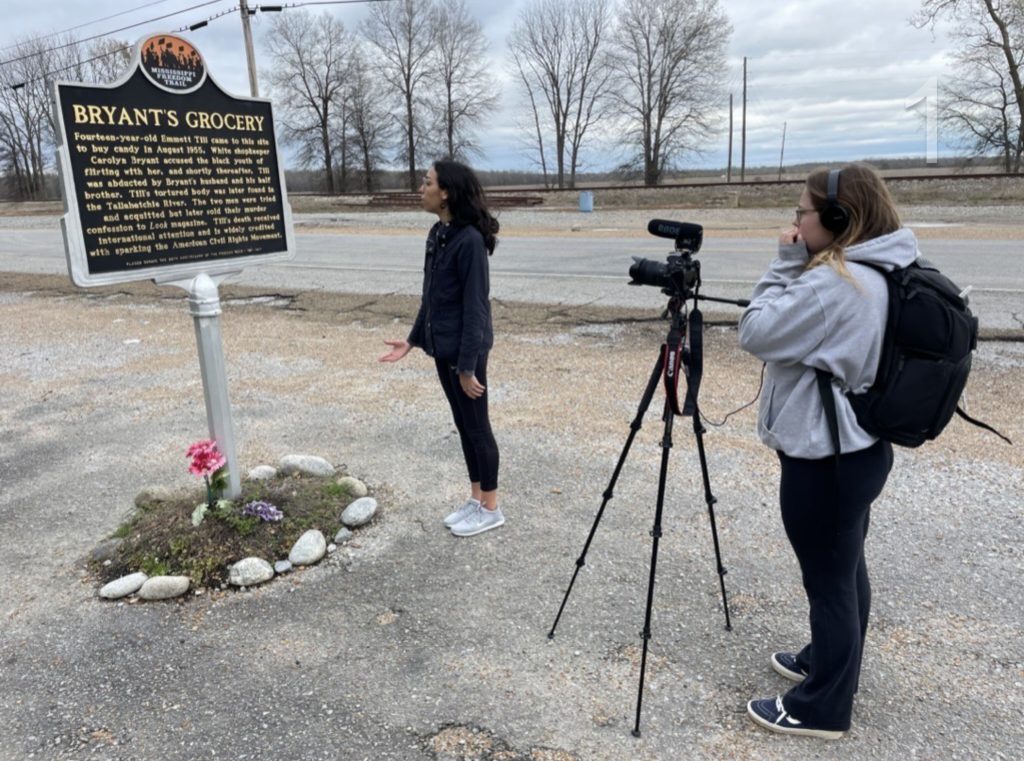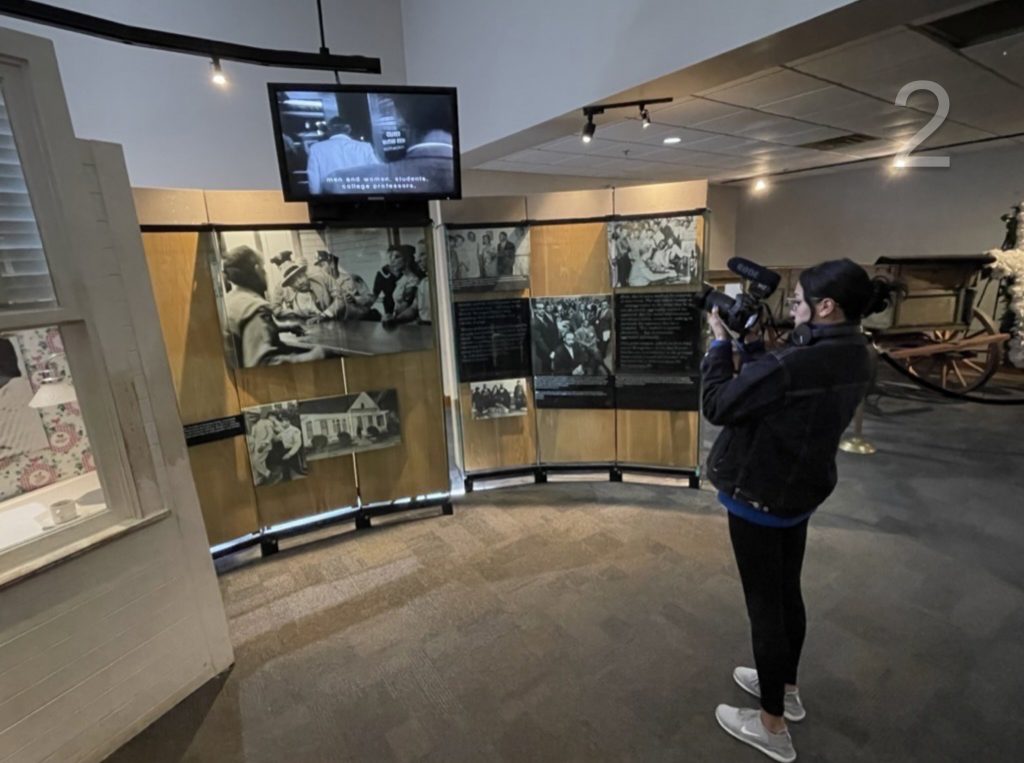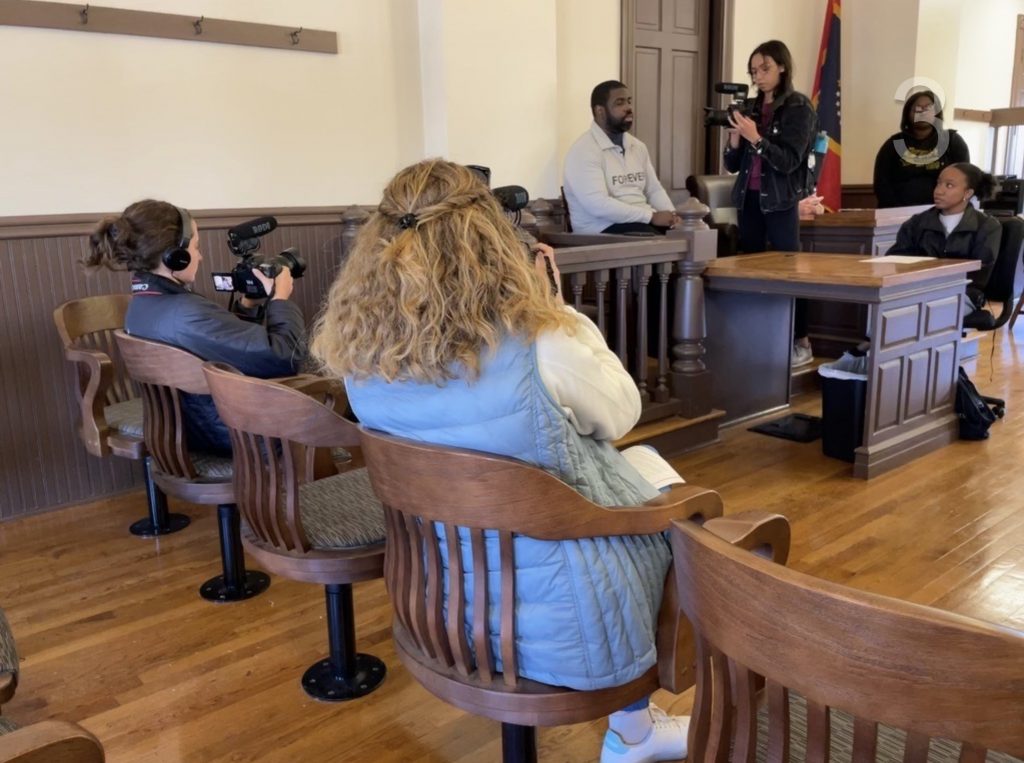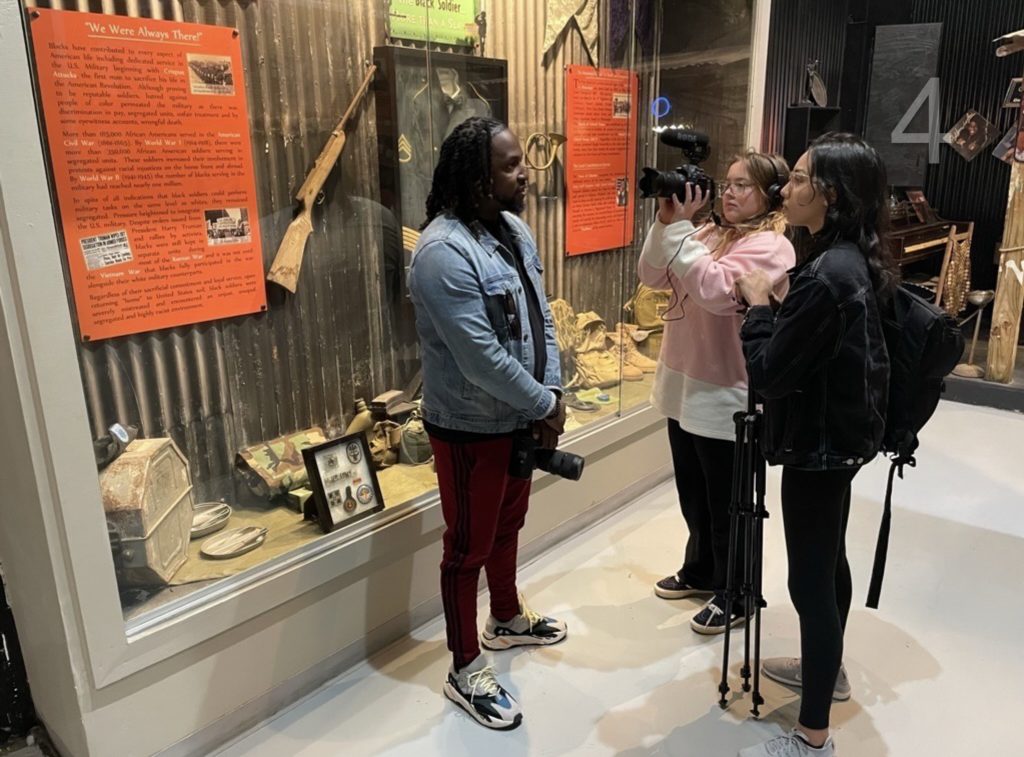By Gabriela Rodriguez | May 22, 2023
Former state attorney general William Baxley and civil rights activist Olivia White express their feelings about living in Alabama; Sixteenth Street Baptist Church member Kathleen Bunton shares how it has persevered after the deadly bombing in Birmingham in 1963; Steve Converse of New York reflects on U.S. history while visiting the Mississippi Civil Rights Museum. (Gabriela Rodriguez/WUFT News)
Three weeks before our class journey across the American South, I left Gainesville to visit my family in Miami. As ladies tiptoed around us at a nail salon to not ruin their pedicures, my mom and I gossiped from our massage chairs. Until, that is, she remembered I would soon visit several cities in five different states during spring break. “Gaby, ten mucho cuidado (Be very careful).” When it’s important to her, my mom tends to speak in Spanish.
A certified public accountant, she reminded me to be aware of my surroundings and to always carry cash. She always tells me to be cautious when visiting new places, but there was emphasis this time. We agreed that this trip was an amazing opportunity, and she was the first to say I should not pass it up. But I was fretting spending dozens of hours in a packed 15-passenger van headed to unfamiliar places. Indeed, I even wondered whether to bring pepper spray.
I had always viewed the South uneasily. Learning about slavery and the Jim Crow era in middle and high school had always frightened me. But then our lead instructor, Professor Herbert Lowe, assigned our class to read “The Race Beat: The Press, the Civil Rights Struggle and the Awakening of a Nation,” by Gene Roberts and Hank Klibanoff. Lowe said the book would give us much-needed context for where we would visit. I hate to admit it, but he was right.
“The Race Beat” focuses on the crucial events of the Civil Rights Movement that are often left out in textbooks. Why had I not been taught before about the “Little Rock Nine”: the courageous Black students who integrated Little Rock Central High School in Arkansas in 1957? The book showed that the movement benefited from the journalists who consistently put their lives in danger exposing the segregationist South to the rest of the nation. Their coverage of pivotal moments propelled the movement, month by month, year by year. As a student journalist, I admire their determination and dedication.
While “The Race Beat” certainly prepared us, it also frightened me. People living in these cities during those times were targeted because of their skin color. We would stand where Black Americans were kidnapped, tortured, lynched and otherwise killed. We would visit the graves of heroes who died for freedom. I was worried about our journey – but couldn’t chicken out.
It turns out that this semester-long journey was one of the best choices I have ever made, and the people who accompanied me made it even better. In February, my fellow Gators and I traveled nearly two hours east to St. Augustine for a reporting trip at the ACCORD Civil Rights Museum. Things didn’t go as planned, as it seems the museum coordinator had forgotten we were coming. But with inspiration and guidance from our co-instructor, Kalisha Whitman, we quickly adapted, something that would come in handy during spring break. As we stood on the museum’s front lawn, we brainstormed a new plan: Searching for neighborhood historical markers related to the Civil Rights Movement in America’s oldest city.
In this report, people interviewed in Tuscaloosa, Alabama; Glendora and Jackson, Mississippi, and Montgomery, Alabama, reflect on African American history and its significance. (Gabriela Rodriguez/WUFT News)
That’s also when I became friends with classmate Paris Coughlin. We worked together in St. Augustine and did so during spring break. In a hotel dining room in Clarksdale, Mississippi, for example, we worked past midnight to sort through footage to create a video for the WUFT News social media page. The next day, on our way to Little Rock, we sat shoulder to shoulder in the last row of the van, editing more footage en route to another social media video posting. Thankfully, Paris kindly dealt with my idiotic questions, and taught me how to use the software. I am very proud of what we accomplished. We did that thing.
Combining forces with students from Florida Agricultural and Mechanical University (FAMU) was a highlight of the trip. We cracked jokes and shared insightful conversations about not only things we learned along the way, but also our thoughts about the troubled history and places we visited along the way. I feel blessed to have experienced it with them.
Reflecting on the places we visited, I think about how much I learned. This was also the first time that I learned about Medgar Evers, the NAACP field secretary who was shot and killed in his driveway in Jackson, Mississippi, in 1963. Standing on his driveway outside his home – at what is now a national monument – 60 years later made me think about his death, and how a person could be so cruel to kill a man as he was a mere steps away from his wife and children.
As we traveled from place to place, I also couldn’t understand people’s wickedness.
St. James Hotel employee Neek Neelie shares her story of growing up in Selma, Alabama, her grandmother’s remembrance of what she witnessed on Bloody Sunday there nearly 60 years ago, and what it’s been like living in the city after a tornado wreaked havoc in January. (Gabriela Rodriguez/WUFT News)
I’ll never forget visiting the National Memorial for Peace and Justice, also known as the lynching memorial, in Montgomery, Alabama. Steel columns hung from the roof of the memorial, listing the names of people who were lynched and in which U.S. county it happened. It sometimes seemed as pairs of feet were dangling inches above me. According to the Equal Justice Initiative, more than 4,000 people were lynched in the South between 1877 and 1950. To me, that’s an incredibly large number, and it makes me sad that it’s still so little talked about.
Inside The Legacy Museum, a few blocks away in Montgomery, there was a massive wall filled with signs that displayed racial slurs and bigotry. One sign among them stated that Negroes – well, actually it was the harsher word, one which I don’t want to repeat here – along with Mexicans and Puerto Ricans weren’t allowed into a certain establishment. I can still see the sign’s bold, red letters. I hated how it categorized all Hispanics, and how they referred to African-Americans. But the sign also helped me envision what my life would have looked like if I had been a Hispanic woman living in the South decades ago.
We visited lots more museums across the South, and together they were enlightening but also jarring. To learn the truth about my nation’s past was difficult, but the history I learned allowed me to greatly appreciate the work of civil rights activists and leaders then and now.




The legacy of evil presented itself as a constant theme throughout our travels – but so did kindness. Local residents, tourists and tour guides always seemed welcoming. They didn’t turn me away and never hesitated to speak. I had expected at least some people to divert my questions or deny the South’s past, but they did not. They wanted to talk. To my surprise, the South was not as frightening as I thought it to be. Yes, its history is unpleasant, and standing in some of the places we visited evoked eerie feelings, but the people we met made the South feel warm.
The history I have learned along the U.S. Civil Rights Trail will stay with me for the rest of my life. I’m excited to share what I’ve learned with others and, hopefully, they too can learn from my experiences. Again, my perceptions of the South have changed. Its people preserve the South’s history related to slavery, lynching and the quest for civil rights for all, so generations like mine can learn from it. It’s my hope that knowing our history can allow us to do better.